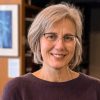This article is more than 5 years old.
Today was the first official day of the RBMS preconference in Charlottesville. It’s the 50th annual RBMS, so we learned a lot about the history of the section. Plenary sessions began with a reminiscence by David Stam, University Librarian Emeritus at Syracuse, who had attended the first RBMS as a 23-year-old brand new employee at NYPL. Then there was the Keynote by the President of UVA, John Casteen, who emphasized the importance of primary sources in scholarly research.
The second plenary session featured Beverly Lynch discussing the interrelationship and parallel development of ACRL, RBMS, and library education.
All of the speakers were interesting, but the session that had me furiously taking notes was the presentation by Francis Blouin, director of the Bentley Historical Library at U of Michigan. Blouin’s talk was titled “Working with Our Research Communities”, but he managed in the space of 30 minutes to sum up the major challenges facing special collections today and to suggest some approaches that librarians and archivists should take to meet these challenges.
In brief, the two most important developments for special collections in the past 50 yearswere the birth of the digital world and the changes in historical approaches in scholarly research.
The challenges of digitization are well known and frequently discussed: digital access to special collections materials forces us to reconsider the importance of owning actual objects and changes the relationship between librarian/archivist and user. The concept of special collections as physical spaces has to be reconsidered– collections will become like banks, with most users of materials never setting foot in the actual buildings. And the challenge of archiving digital materials is a huge one. Blouin suggested that special collections need to recognize the importance of conceptual frameworks over ownership: we need to explain our collections and put them into context, not just acquire and index items.
The second major challenge that Blouin discussed was what he termed the Archival Divide. He suggested that special collections and the historical scholarship it has traditionally supported are on divergent paths of development. Fifty years ago there was convergenceof how special collections were described and maintained and how they were used. Archives collected the materials that scholars agreed were important, and thus had a monopoly on authoritative historical understanding. However, developments in social history, deconstruction of language, etc. havechanged this relationship.Scholars now look for historical evidence in materials outside the scope of traditional archival collections. And they are using materials in ways not addressed by traditional descriptive formats. Meanwhile, special collections have been faced with many new issues: technical challenges of DB and systems design (which demand precision in language and authority control), changing demands of diverse constituencies, broader definitions of what constitutes a historical document.
In sum, researchers are looking to use special collections materials in complex ways which cannot be understood by traditional theories of information-seeking. Referring to the ACLS Committee on Cyberinfrastructure report, Blouin suggested that librarians andarchivists must take the lead in organizing new knowledge structures.
Blouin’s concluding points on the future relationship of special collections and academic research:
- Scholars will have more responsibility for identifying information communities
- Traditional finding aid structures will be supplemented by these information communities
- There will be a need for more attention to EAD and cross-collection indexing– “subcatalogs” supplementing traditional catalog.
- Special collections will continue to exist as an academic and intellectualcenter, not just collection of materials;emphasis on teaching with collections,visible academic personnel, special programs.
- Special Collections, finally, are a point of mediation between old and new ways of creating and recording knowledge and ideas; special collections is a place of connection, not just a repository of static materials.
My afternoon seminar of choice was “Partners in Processing: Students, Volunteers, and Paraprofessionals in the Library”. Three presentations on using non-MLS personnel to address the ubiquitous problem of the special collections backlog. Presenters from UCLA, Yale, and the Thomas Jefferson Foundation Library– all very different institutions from WFU, but still there were some interesting ideas. I was particularly intrigued by UCLA’s Center for Primary Research and Training, which provides fellowships for graduate students to work on processing manuscript collections in the library. Jack Robertson of the Jefferson Foundation described inspiringly ingenious solutions to the problems of a growing collection with a small professional staff. Aftertheir project of reconstructing Jefferson’s libraries was turned down for grant funding, the foundationgave Jefferson a membership on LibraryThing. And after six months of unsuccessful attempts to correct and enhance the Wikipedia entry on Jefferson, they gave up and started their own wiki (called the Jefferson Encyclopedia, because their BOT objected to the term wiki!).
The student/volunteer processingsuccess stories were very encouraging, since we’re about to undertake a similar project.

1 Comment on ‘RBMS day 2’
The Blouin presentation is great stuff. It can inform our conversation on July 1!